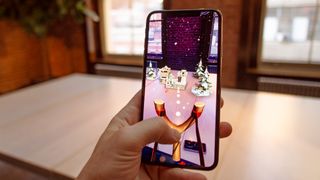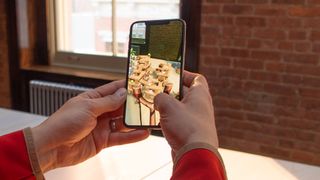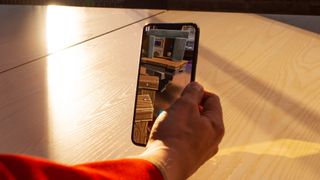Slingshot into AR: Angry Birds in augmented reality coming to your iPhone and iPad
The most convincing AR game we've seen on mobile

Angry Birds is taking the battle to another dimension: ours. The popular franchise’s next mobile game, Angry Birds: Isle of Pigs, will harness augmented reality to let players knock down pig-filled fortresses animated over your everyday world.
If this sounds familiar, it’s because a version of this game had been announced in fall 2018 as Angry Birds: First Person Slingshot...for the Magic Leap. There’s even a VR version of Isle of Pigs that launched in February 2019 for the HTC Vive and Oculus Rift. But we did say mobile: you’ll be able to play this new edition of Isle of Pigs on most iOS devices as a free-to-play game.
TechRadar got an early look at the title in the weeks leading up to GDC 2019. Rovio Entertainment, the studio behind the Angry Birds franchise, gave a live demonstration of Isle of Pigs, which was developed by Resolution Games (as were the earlier Magic Leap and VR versions). TechRadar saw how it will play on a smartphone...and the answer is, surprisingly well.
Angry Birds: Isle of Pigs has the same basic goals as the puzzle games in the franchise: toss different kinds of birds into elaborate forts populated by the villainous pigs. As players progress, fortifications become more elaborate, requiring precision and novel tactics to topple targets and win the day.
Except this time, the forts are superimposed over objects in real life, and you’re launching birds from a first-person perspective, altering your aim by tilting your phone and firing with real-world telemetry.

Like other AR games, Isle of Pigs uses your iOS device’s camera to situate a digital object in real space (don’t worry, you won’t need fancy specs to play the game – any ARKit-compatible iOS device works, including the iPhone 6S and newer iPhones, iPad 5th and 6th generations, and all iPad Pros). And that means, like other AR games, you’re able to physically walk around these levels to fire your birds from any direction to find better angles.
That’s something dynamically new to franchise, which has previously kept its puzzle gameplay on a flat plane. Not all game concepts translate well from 2D to 3D, but when it came to classic Angry Birds slingshot gameplay, the transition was surprisingly straight-forward, Resolution Games CEO Tommy Palm told TechRadar over email.
Get daily insight, inspiration and deals in your inbox
Get the hottest deals available in your inbox plus news, reviews, opinion, analysis and more from the TechRadar team.
“One difference from the 2D gameplay is that in the AR version you can place the slingshot wherever you want,” Palm said – as in, you physically move around to change the angle of your shot. “We did this to encourage the player to move around, which makes the game feel more real, and achieve that balance of using the physical space within the gameplay. But, that created a challenge for us as the levels had to be designed for this, which took fine-tuning to make it feel just right.”
We saw this careful design in the short time we had to try out the game (on an iPhone XS Max, if you’re curious). Rovio Creative Director Sami Ronkainen guided us through the neat parts of the title. AR is so new that the Resolution Games team had to “teach” people how to physically walk around the level by showing off dynamic visuals – like a domino effect, for example.
Once players learn to circle around levels, they’ll find what the devs have hidden around the levels – mostly just better angles to topple structures, but sometimes they’ll discover a dynamite pack nested in the middle of the stage. Players will have to examine levels from different perspectives to form a plan of attack that will get them three-star level completion.
And the Resolution team got to have a little design fun with AR, too. In the fading evening light filtering through the Manhattan loft, Ronkainen pointed out how stone and wood blocks reacted differently to the real-world sunlight. This changes in the various biomes players traverse between in-game worlds, which all have their own signature materials.

There are limits when adapting a game from the $2,295 (about £1,731 or AU$3,073) Magic Leap to work with smartphones that might be four years old. Ronkainen “placed” the game on a broad off-white table in the loft, noting that iOS device cameras don’t see white surfaces well, and black surfaces aren’t seen at all. This is limited by the ARKit software, its machine vision and what the phone camera is actually able to “see” in its visual tracking.
But AR as a whole is early in its development, and a lot of cool ideas just aren’t possible right now – on any AR platform.
“We discussed having levels where you could bounce birds off of walls in order to get pool table-like shots, but currently plane detection is better on horizontal surfaces so we cut that idea in an early phase,” Palm said. In essence, featureless (often white) walls make it harder to detect surfaces, as distinct features are better for AR.
But even at this early stage of AR, bringing big and experimental titles to mobile is a huge jump. Not everyone has the money to buy bespoke devices like Magic Leap or other ML-equipped and VR platforms – but almost everyone has a smartphone.
And making AR accessible to the masses opens up different kinds of play and design. Unlike previous Angry Birds titles that lock you at a distance, this one lets you literally walk up to the targets and let loose your furious fowl projectiles. It felt like cheating – but an Apple representative kindly told us it wasn’t. It was all part of the strategy in a new AR world.
Angry Birds: Isle of Pigs will be available for preorder starting today (March 19) – essentially just to be alerted when the game comes out later this spring, since it’s free-to-play. The game will only be compatible with ARKit-supporting iOS devices, though they’re investigating other AR supported platforms.
David is now a mobile reporter at Cnet. Formerly Mobile Editor, US for TechRadar, he covered phones, tablets, and wearables. He still thinks the iPhone 4 is the best-looking smartphone ever made. He's most interested in technology, gaming and culture – and where they overlap and change our lives. His current beat explores how our on-the-go existence is affected by new gadgets, carrier coverage expansions, and corporate strategy shifts.

